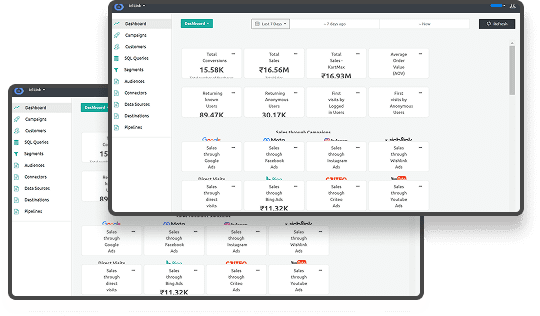TLDR
- ROAS Definition: ROAS measures revenue per dollar spent on ads, with prospecting often requiring more optimization for better returns.
- Key Factors: Targeting, ad creative, budget allocation, and conversion tracking all impact ROAS.
- Boost ROAS: Segment your audience, personalize ads, make data-driven decisions, and optimize landing pages.
- Ongoing Monitoring: Regularly analyze performance, shift budgets to top-performing channels, and utilize multi-touch attribution for accurate insights.
Are your prospecting campaigns draining ad budgets without precise results?
Many e-commerce brands, agencies, and SaaS companies encounter this issue, often due to inadequate attribution and fragmented tracking systems. In the U.S. alone, over $390 billion will be spent on advertising this year, yet much of it lacks measurable returns due to disconnected data sources.
High ROAS prospecting focuses on creating efficient acquisition systems through accurate data and clear performance signals rather than chasing flashy metrics. When set up correctly, it attracts better traffic, reduces customer acquisition costs, and scales without guesswork.
What is ROAS in Prospecting?
Return on Ad Spend (ROAS) indicates the revenue generated by your ad campaigns per dollar spent. While retargeting often yields high returns, prospecting campaigns targeting cold audiences tend to produce lower ROAS unless highly optimized.
Effective prospecting is about more than just conversions. It’s about building quality top-funnel traffic and collecting clean, privacy-safe data to power future growth. That’s why improving ROAS here requires long-term thinking backed by better tech.
Now that you understand ROAS let’s look at the main factors that can affect your ROAS in prospecting.
Key Factors Affecting ROAS in Prospecting Strategies
Several factors can impact your ROAS. Understanding these factors can help you find ways to improve your results.
1 Target Audience Selection
Reaching the right audience is crucial for a high ROAS. By identifying your ideal customers and targeting them specifically, you can ensure that your ads are seen by those who are more likely to convert. Use behavioral segmentation to tailor your audience based on their actions and preferences.
2 Ad Creative and Messaging
Your ad’s design and message play a big role in attracting and engaging prospects. Ads that speak directly to your audience’s needs and interests can lead to higher engagement and more conversions. Discover how to create personalized experiences with first-party data, enhancing the effectiveness of your ads.
3 Budget Allocation
How you spread your marketing budget across different channels can affect your ROAS. Investing more in channels that perform well and cutting back on those that don’t can help maximize your returns. Understanding first-party, second-party, and third-party data can help you allocate your budget smartly.
4 Data Utilization
Using data to inform your marketing decisions is crucial for improving ROAS. Data-driven strategies let you adjust your campaigns based on real insights, making them more effective. Implementing real-time analytics can provide immediate feedback to optimize your prospecting efforts.
5 Conversion Tracking and Attribution
Tracking your conversions accurately and understanding which channels drive results are essential for assessing your Return on Ad Spend (ROAS). Proper tracking enables you to identify which parts of your campaign are working and which require improvement. Explore multi-touch attribution to gain a deeper understanding of your customer's journey.
As the key factors in action are discussed, it's time to ask: What ROAS should you aim for, and when is it truly working for you?
Also watch: Increase your ROAS by 25% in 30 days with these 4 easy changes.
What Is a Good ROAS in Prospecting?
There’s no universal benchmark for a “good” ROAS; what’s considered strong depends heavily on your industry, business model, and cost structure. However, in prospecting campaigns targeting cold audiences, most brands find that a ROAS between 1.5:1 and 3:1 is typical. Anything higher than that often indicates a highly efficient acquisition strategy.
For example:
- Retail brands may aim for a ROAS of 4:1 to 5:1 due to narrower margins.
- SaaS companies may find 3:1 acceptable because of substantial lifetime value and recurring revenue.
- Service providers, such as consultancies, may require a 6:1 or higher ratio due to high overhead and longer sales cycles.
Ultimately, what qualifies as “good” depends on your break-even point, customer lifetime value, and strategic goals. A high ROAS may look excellent on paper, but it doesn't always reflect the entire picture.
But before assuming higher is always better, it's worth understanding what you gain and what you might lose when chasing a high ROAS.
Advantages of a High ROAS
A strong ROAS means more revenue for every dollar spent, but its benefits extend further:
- Efficient Use of Budget: A high ROAS indicates that you're generating solid revenue from minimal spending. This directly improves profit margins and reduces waste in paid acquisition.
- Smarter Resource Allocation: It helps identify the campaigns and channels that drive the most substantial returns, allowing you to double down on what works and scale performance without burning through budget.
- Competitive Performance: Consistent, high ROAS gives your business an edge, keeping customer acquisition cost-efficient while maintaining healthy margins in a competitive ad environment.
That said, all upsides come with trade-offs. Aiming too high can sometimes throw your strategy off balance. Let's also consider the disadvantages.
Disadvantages of a High ROAS
Ironically, obsessing over high ROAS can limit long-term growth if you’re not careful:
- Underinvesting in Prospecting: High ROAS often comes from bottom-funnel, purchase-ready audiences. If you neglect top-of-funnel prospecting to chase only warm leads, your growth pipeline may dry up.
- Ad Fatigue and Market Saturation: Excessive spending on the same high-performing audiences can lead to ad fatigue, reduced performance, and increased costs as you repeatedly target the same user base.
- Short-Term Mindset: Prioritizing ROAS over broader growth metrics can lead to an overemphasis on short-term revenue while undervaluing customer lifetime value, brand awareness, and long-term acquisition channels.
So, how do you benefit from a high ROAS without falling into these traps? That’s where balance becomes key.
Striking the Right Balance
Instead of chasing only a high ROAS, successful businesses focus on balanced strategies that blend immediate returns with long-term growth.
- Mix prospecting and retargeting: Blend high-ROAS campaigns with top-funnel efforts to bring in new audiences consistently.
- Measure holistically: Combine ROAS with metrics such as CPA, LTV, AOV, and CAC payback period to gain a clearer picture of performance and potential.
- Stay agile: Markets shift quickly. Continue testing new audiences, creatives, and channels, even when your current ROAS is strong.
Next, let’s explore how to calculate your ROAS to accurately measure the success of your campaign.
How to Calculate ROAS for Prospecting Campaigns?
Knowing how to calculate ROAS is crucial for evaluating the effectiveness of your prospecting campaigns. Here’s a simple way to do it:
| ROAS=Revenue from Ad Campaign/Cost of Ad Campaign |
Steps to Calculate ROAS:
1 Identify Revenue Sources
Begin by determining which sales or conversions directly result from prospecting efforts.
- Filter out retargeting or branded traffic and only include conversions from cold audiences.
- Use UTM tracking, ad platform reports, and first-party identifiers to distinguish prospecting traffic accurately.
- Attribute revenue using consistent logic across campaigns (e.g., 7-day click, 1-day view).
2 Track Campaign Costs
Capture the full cost of running your prospecting campaigns—not just media spend.
- Include platform spend (Google, Meta, TikTok), creative production, agency fees, and content development.
- Factor in data infrastructure costs, such as tag management, analytics, and tracking tools (e.g., server-side tagging with Ingest IQ).
- Don’t ignore hidden costs: A/B testing tools, reporting dashboards, or manual labor hours.
3 Apply the ROAS Formula
Use the ROAS formula to calculate your return on investment from prospecting.
- Formula: ROAS = Total Revenue from Prospecting / Total Prospecting Costs
- Run this calculation per campaign or per channel to identify where ROAS is highest.
- Track changes weekly or bi-weekly for accurate optimization and budget allocation decisions.
Calculating ROAS accurately helps you identify which campaigns are working and make more informed marketing decisions. For more details, refer to our guide on how to calculate ROAS.
Once you’ve nailed down how to measure ROAS, the next step is to analyze it deeply rather than accepting surface-level numbers.
Analyzing ROAS the Right Way
You can’t improve what you don’t measure consistently. In high ROAS prospecting, surface-level metrics hide deeper performance patterns that impact long-term returns. Here’s how to evaluate ROAS with more precision and clarity:
1 Break Down ROAS by Channel, Campaign, and Creative
Don’t look at ROAS as a single number. Segment by ad channel (Google, Meta, TikTok), campaign objective, and creative asset.
- This reveals which combinations produce the strongest return.
- Use real-time dashboards or server-side analytics for deeper visibility.
2 Monitor Weekly Trends; Not Just Monthly Averages
High-level reports miss early signals. Weekly trend monitoring helps you catch drops or gains early.
- Look for shifts in cost per conversion, click-through rates, and revenue patterns.
- Investigate anomalies, especially after creative updates or targeting changes.
3 Adopt Multi-Touch Attribution to Fairly Credit Conversions
Prospecting often starts the journey, but other touchpoints close the sale. Assign a fair value across all interactions.
- Use models like linear, time decay, or position-based—avoid last-click for top-of-funnel efforts.
- This ensures your prospecting budget doesn’t get undervalued in reporting.
4 Shift Budgets to Channels with Strongest ROI Signals
Let performance dictate investment. Channels with consistent ROAS growth should earn larger shares of your budget.
- Test small shifts first, then scale based on week-over-week improvements.
- Watch for diminishing returns as spending increases, and avoid saturating cold audiences.
By thoroughly analyzing your ROAS, you can make informed decisions to improve your prospecting campaigns. For more tips, explore real-time data streaming for marketing insights.
Janky Patel has shared a LinkedIn post showcasing how she implemented a 3-step strategy that increased ROAS by 44% in 75 days.
ROAS doesn’t exist in a vacuum; benchmarks and internal data behavior also help you know what "good" looks like.
Benchmarks and Data Characteristics for ROAS in Prospecting
To determine if your ROAS is effective, it's helpful to compare it to industry benchmarks and understand the data behind your campaigns.
1 Industry Benchmarks
Different industries have different average ROAS. For example, an e-commerce business might expect a different return on ad spend (ROAS) compared to a B2B service provider. Researching industry-specific benchmarks helps you set realistic goals and compare your ROAS to others.
2 Data Characteristics
Several data points can influence your ROAS:
- Customer Lifetime Value (CLV): Understanding how much a customer is worth over time enables you to determine the optimal investment to acquire them. Discover how to calculate customer lifetime value.
- Conversion Rates: Higher conversion rates result in a better return on ad spend (ROAS). Analyzing your conversion funnels can help you identify areas for improvement.
- Cost Per Acquisition (CPA): Monitoring your CPA ensures you’re not overspending to acquire a customer.
By understanding these data characteristics, you can more effectively evaluate your ROAS and identify opportunities for improvement. For more insights, check out understanding and optimizing conversion funnels.
With benchmarks and data characteristics in mind, let’s proceed to analyze your ROAS to assess how your campaigns are performing.
Now that you know about benchmarks and characteristics, let’s look at some effective techniques to boost your ROAS in prospecting.
Effective Techniques to Improve ROAS Prospection
Raising your ROAS in cold-audience campaigns requires precise execution across targeting, creative, tracking, and attribution. These techniques are designed to deliver a measurable impact on prospecting performance.
1 Optimize Your Target Audience
The better your audience fit, the higher your conversion efficiency and your high ROAS prospecting gains follow.
- Use behavioral segmentation built on user actions (not just demographics).
- Segment by content consumed, product pages viewed, or time spent on site.
- Classify visitors into intent-based tiers: high-interest, moderate interest, and informational.
- High-interest users should receive dynamic product ads.
- Informational users should see top-funnel educational content.
- Deploy exclusion lists to avoid retargeting repeat users in prospecting campaigns.
- Build lookalike audiences from the highest-LTV users rather than all past purchasers.
- With Ingest ID, you can unify user identities across sessions and devices, ensuring your audience segments are always accurate and actionable.
2 Enhance Ad Creative and Messaging
Creative relevance drives engagement. Generic ads waste spend and suppress ROAS in cold campaigns.
- Personalize visuals and messaging by user segment.
- Show different creatives for mobile vs. desktop users.
- Adjust CTAs based on funnel position.
- A/B test creative combinations weekly, not monthly, for faster data cycles
- Localize messaging for geographic relevance, particularly in regulated markets such as the US and Canada.
- Ingest Labs’ Media Data Platform helps to analyze which creative assets and messages drive the highest engagement across your prospecting audiences.
3 Data-Driven Decision Making
Smart prospecting decisions come from real-time, trustworthy data, not lagging metrics or assumptions.
- Utilize server-side tracking to consolidate cross-channel insights into a unified dashboard.
- Track daily changes in ROAS, CPA, and CTR to catch anomalies early.
- Integrate customer journey mapping to visualize drop-off points across devices and sessions.
- The Ingest Labs UI provides intuitive navigation and real-time dashboards, enabling you to drill down into campaign performance and audience behavior instantly.
4 Implement Server-Side Tagging with Ingest Labs
Accurate, privacy-compliant data feeds better decisions and protects ROAS from blind spots.
- Replace browser-side tags with server-side containers via Ingest IQ.
- Send real-time conversion events to ad platforms even when cookies are restricted.
- Improve site speed by reducing client-side script load, enhancing UX, and conversion rates.
- Ingest Labs Tag Manager allows you to deploy, manage, and QA all your tags centrally, minimizing errors and maximizing data reliability.
5 Monitor and Adjust Campaigns Proactively
Minor data errors can often lead to significant ROAS losses. Ongoing QA ensures consistent performance.
- Set automated alerts for pixel drops, tag duplication, or sudden drops in conversion rates.
- Utilize tag monitoring tools from Ingest Labs to verify data integrity daily.
- Maintain documentation of tag changes and campaign rollout timelines to identify and address anomalies.
6 Use Advanced Attribution Models
High ROAS prospecting requires crediting assist channels properly, not just the last click.
- Implement multi-touch attribution models (e.g., linear or U-shaped).
- Assign value to first impressions and mid-funnel engagements that impact final conversions.
- Use Ingest Event IQ to unify tracking across sessions, devices, and ad platforms.
7 Optimize Landing Pages for Prospecting Traffic
Cold users bounce quickly if the value isn't apparent. Landing pages must reduce friction and build clarity fast.
- Use single-focus landing pages for top-funnel campaigns.
- Highlight one product, one message, and one call to action.
- Remove header links that distract from the conversion goal.
- Replace with anchored CTAs that scroll to action points.
- Add urgency elements, such as timers or limited-offer badges.
- Compress images, enable lazy loading, and ensure mobile-first design.
- Utilize dynamic content to align with ad intent (e.g., keyword-specific headlines).
Check out understanding and improving core web vitals for tips on optimizing your website performance.
By following these best practices, you can maintain a high ROAS in your prospecting campaigns, ensuring ongoing growth and success for your business.
For more strategies, visit how to calculate ROAS.
Conclusion
Improving ROAS in prospecting campaigns is crucial for ensuring that every dollar spent on ads delivers significant returns. As digital marketing becomes increasingly complex, understanding the key factors influencing ROAS—such as audience targeting, ad creative, data utilization, and conversion tracking—becomes paramount for sustained success. By optimizing these elements, businesses can achieve better results, reduce wasted ad spend, and scale their marketing efforts effectively.
Ingest Labs offers powerful tools that can help marketers enhance their ROAS through smarter data management and precise tracking. With products like Ingest IQ, Ingest ID, and Event IQ, businesses can improve data integration, personalize user experiences, and gain real-time insights into campaign performance. These platforms ensure privacy-compliant tracking, accurate attribution, and seamless multi-channel marketing, giving you the tools needed to optimize your prospecting efforts and boost your returns.
Ready to boost your ROAS?
Contact Ingest Labs today to find out how our advanced Martech solutions can support your marketing efforts and deliver exceptional returns on your ad spend
FAQs
1. What is ROAS in ads?
ROAS (Return on Ad Spend) measures how much revenue you earn for every dollar spent on advertising. It helps evaluate campaign performance.
2. What is ROAS in KPI?
ROAS is a key performance indicator used to assess the profitability of marketing campaigns. A higher ROAS indicates better ad efficiency.
3. What’s a good ROAS for prospecting campaigns?
For prospecting, a ROAS between 1.5 and 3 is common, depending on your industry and margins. Cold audiences typically return lower than retargeting.
4. How is ROAS different from ROI?
ROAS looks specifically at ad spend, while ROI considers all business costs. ROAS is narrower, but it is helpful for campaign-level insights.
5. Can ROAS improve without increasing conversions?
Yes—by lowering ad spend, increasing average order value, or tightening targeting, you can improve ROAS even with steady conversions.






